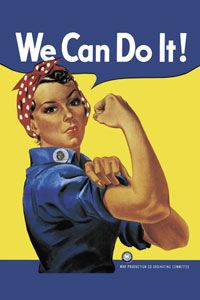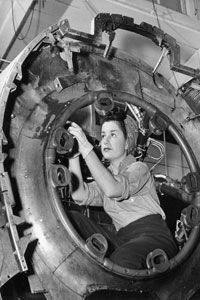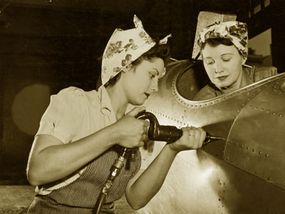As American men left for the war front in World War II, they left behind vitally important factory, war production plant and civil service jobs. These were booming industries, thanks to increased demand caused by the war, or positions necessary for daily life, like post office workers. It was quite a predicament, and the U.S. government turned to the War Advertising Council, which implemented a massive national campaign to usher women into the workplace. Known as the Women in War Jobs campaign, it is considered even today to be the advertising industry's most successful "recruitment" campaign in the United States [source: Ad Council].
The propaganda campaign utilized a series of persuasive patriotic posters and messages featuring different versions of the now-legendary icon Rosie the Riveter. One version of Rosie painted by Saturday Evening Post artist Norman Rockwell depicts the antithesis of prewar femininity: a muscular woman in factory garb, brandishing a riveting machine and her lunch box. (You can see Rockwell's painting on the Rosie the Riveter memorial Web site.)
Advertisement
The campaign targeted several groups of women. First, women already in the workplace (particularly minority women and those who held low-paying positions) were encouraged to upgrade to factory jobs with better wages. Next, girls barely out of high school were recruited. After it became obvious that still more workers were necessary, the campaign went after married women with children who didn't really need -- or even want -- to work. Several persuasive messages permeated the campaign, especially the importance of patriotism and the idea that the war would end sooner if women at home filled the shoes of absent male workers. Fear propaganda also insisted that more soldiers would perish and women would be considered "slackers" if they didn't step up to the task [source: National Park Service].
These efforts were wildly successful. By 1945, more than 18 million women were in the workforce -- up from 12 million in 1940. Many of these women were employed in traditionally male-dominated roles, such as aerodynamic engineers, railroad workers, streetcar drivers and lumber and steel mill employees [source: U.S. Department of Transportation]. Despite the fact that the women were doing the same jobs as their absent male counterparts, they earned roughly 65 percent less [source: PBS]. Women in the workplace also had to contend with the negative attitudes of male co-workers, exclusion from higher-ranking positions and other glass ceiling effects.
So how does Rosie the Riveter figure into all of this?
Advertisement





